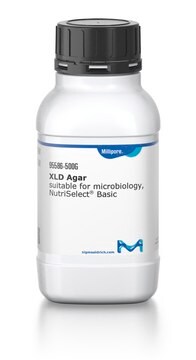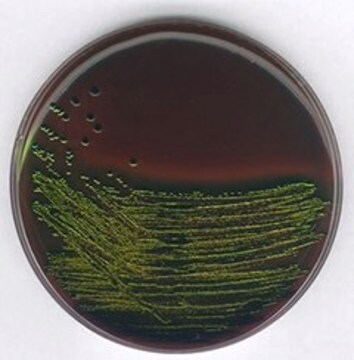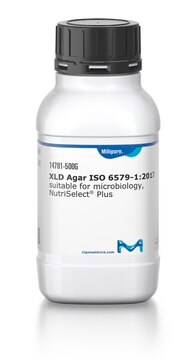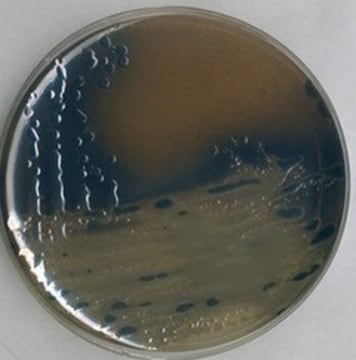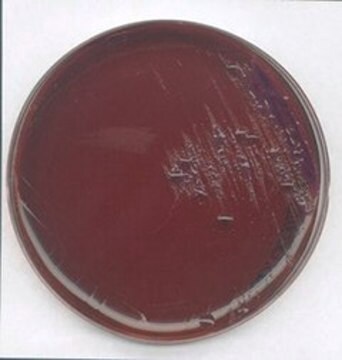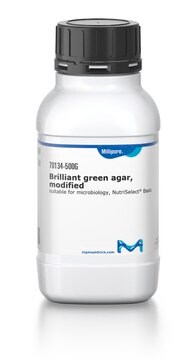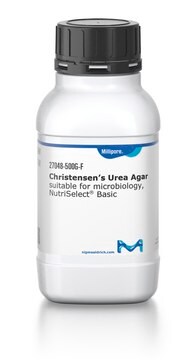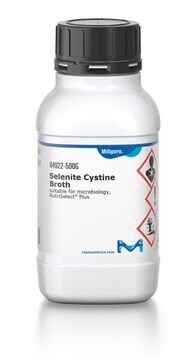51490
enterisches Hektoen-Agar
suitable for microbiology, NutriSelect® Plus
About This Item
Empfohlene Produkte
Sterilität
non-sterile
Qualitätsniveau
Form
powder
Haltbarkeit
limited shelf life, expiry date on the label
Zusammensetzung
acid fuchsin, 0.1 g/L
agar, 15.0 g/L
ammonium ferric citrate, 1.5 g/L
bile salts, 9 g/L
bromothymol blue, 0.065 g/L
lactose, 12 g/L
mixed peptone, 12 g/L
salicin, 2 g/L
sodium chloride, 5 g/L
sodium thiosulfate, 5 g/L
sucrose, 12 g/L
yeast extract, 3 g/L
Hersteller/Markenname
NutriSelect® Plus
Methode(n)
microbiological culture: suitable
pH-Endwert
7.5±0.2 (25 °C)
Anwendung(en)
clinical testing
environmental
food and beverages
water monitoring
microbiology
Eignung
selective and differential for Salmonella spp.
selective and differential for Shigella spp.
selective and differential for bacteria (General Media)
Anwendung
Angaben zur Herstellung
Sonstige Hinweise
Fußnote
The designations basic, plus, or prime are added to indicate the quality control level, from basic quality control to standard QC plus to prime for full regulatory compliance.
Rechtliche Hinweise
Signalwort
Warning
H-Sätze
Gefahreneinstufungen
Skin Sens. 1
Lagerklassenschlüssel
11 - Combustible Solids
WGK
WGK 3
Flammpunkt (°F)
Not applicable
Flammpunkt (°C)
Not applicable
Persönliche Schutzausrüstung
dust mask type N95 (US), Eyeshields, Faceshields, Gloves
Hier finden Sie alle aktuellen Versionen:
Besitzen Sie dieses Produkt bereits?
In der Dokumentenbibliothek finden Sie die Dokumentation zu den Produkten, die Sie kürzlich erworben haben.
Kunden haben sich ebenfalls angesehen
Artikel
Salmonella contamination is the second leading cause of food-borne illness worldwide. Controlling outbreaks of Salmonella is an important task for food regulators, restaurants and the food industry in general. The Salmonella family includes over 2,300 serotypes of bacteria, but two types, Salmonella enteritidis and Salmonella typhimurium, are responsible for about half of all human infections. Most outbreaks of Salmonella are traced back to dairy, poultry and meat products, but Salmonella can grow on nearly any food. Chicken, eggs and their derivative products are particularly high risk.
Unser Team von Wissenschaftlern verfügt über Erfahrung in allen Forschungsbereichen einschließlich Life Science, Materialwissenschaften, chemischer Synthese, Chromatographie, Analytik und vielen mehr..
Setzen Sie sich mit dem technischen Dienst in Verbindung.